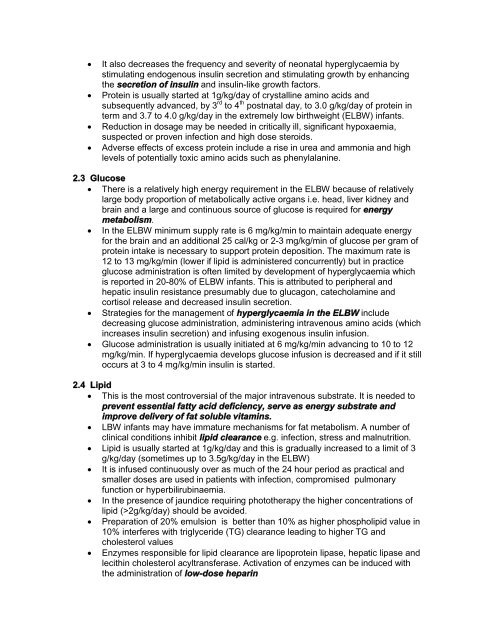Contents Chapter Topic Page Neonatology Respiratory Cardiology
Contents Chapter Topic Page Neonatology Respiratory Cardiology
Contents Chapter Topic Page Neonatology Respiratory Cardiology
You also want an ePaper? Increase the reach of your titles
YUMPU automatically turns print PDFs into web optimized ePapers that Google loves.
It also decreases the frequency and severity of neonatal hyperglycaemia by<br />
stimulating endogenous insulin secretion and stimulating growth by enhancing<br />
the secretion of insulin and insulin-like growth factors.<br />
Protein is usually started at 1g/kg/day of crystalline amino acids and<br />
subsequently advanced, by 3 rd to 4 th postnatal day, to 3.0 g/kg/day of protein in<br />
term and 3.7 to 4.0 g/kg/day in the extremely low birthweight (ELBW) infants.<br />
Reduction in dosage may be needed in critically ill, significant hypoxaemia,<br />
suspected or proven infection and high dose steroids.<br />
Adverse effects of excess protein include a rise in urea and ammonia and high<br />
levels of potentially toxic amino acids such as phenylalanine.<br />
2.3 Glucose<br />
There is a relatively high energy requirement in the ELBW because of relatively<br />
large body proportion of metabolically active organs i.e. head, liver kidney and<br />
brain and a large and continuous source of glucose is required for energy<br />
metabolism.<br />
In the ELBW minimum supply rate is 6 mg/kg/min to maintain adequate energy<br />
for the brain and an additional 25 cal/kg or 2-3 mg/kg/min of glucose per gram of<br />
protein intake is necessary to support protein deposition. The maximum rate is<br />
12 to 13 mg/kg/min (lower if lipid is administered concurrently) but in practice<br />
glucose administration is often limited by development of hyperglycaemia which<br />
is reported in 20-80% of ELBW infants. This is attributed to peripheral and<br />
hepatic insulin resistance presumably due to glucagon, catecholamine and<br />
cortisol release and decreased insulin secretion.<br />
Strategies for the management of hyperglycaemia in the ELBW include<br />
decreasing glucose administration, administering intravenous amino acids (which<br />
increases insulin secretion) and infusing exogenous insulin infusion.<br />
Glucose administration is usually initiated at 6 mg/kg/min advancing to 10 to 12<br />
mg/kg/min. If hyperglycaemia develops glucose infusion is decreased and if it still<br />
occurs at 3 to 4 mg/kg/min insulin is started.<br />
2.4 Lipid<br />
This is the most controversial of the major intravenous substrate. It is needed to<br />
prevent essential fatty acid deficiency, serve as energy substrate and<br />
improve delivery of fat soluble vitamins.<br />
LBW infants may have immature mechanisms for fat metabolism. A number of<br />
clinical conditions inhibit lipid clearance e.g. infection, stress and malnutrition.<br />
Lipid is usually started at 1g/kg/day and this is gradually increased to a limit of 3<br />
g/kg/day (sometimes up to 3.5g/kg/day in the ELBW)<br />
It is infused continuously over as much of the 24 hour period as practical and<br />
smaller doses are used in patients with infection, compromised pulmonary<br />
function or hyperbilirubinaemia.<br />
In the presence of jaundice requiring phototherapy the higher concentrations of<br />
lipid (>2g/kg/day) should be avoided.<br />
Preparation of 20% emulsion is better than 10% as higher phospholipid value in<br />
10% interferes with triglyceride (TG) clearance leading to higher TG and<br />
cholesterol values<br />
Enzymes responsible for lipid clearance are lipoprotein lipase, hepatic lipase and<br />
lecithin cholesterol acyltransferase. Activation of enzymes can be induced with<br />
the administration of low-dose heparin
















